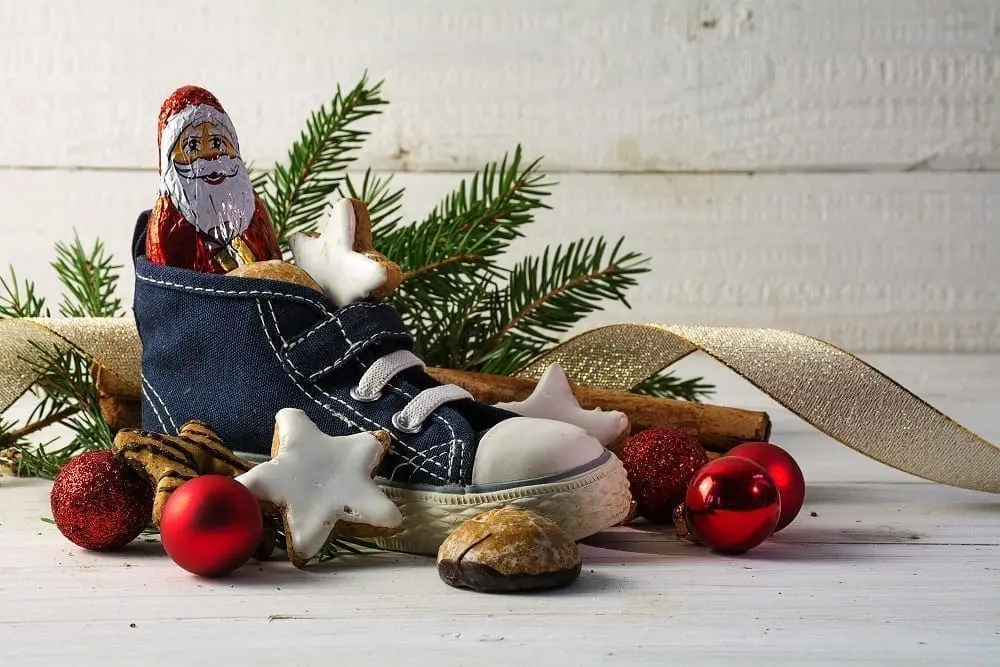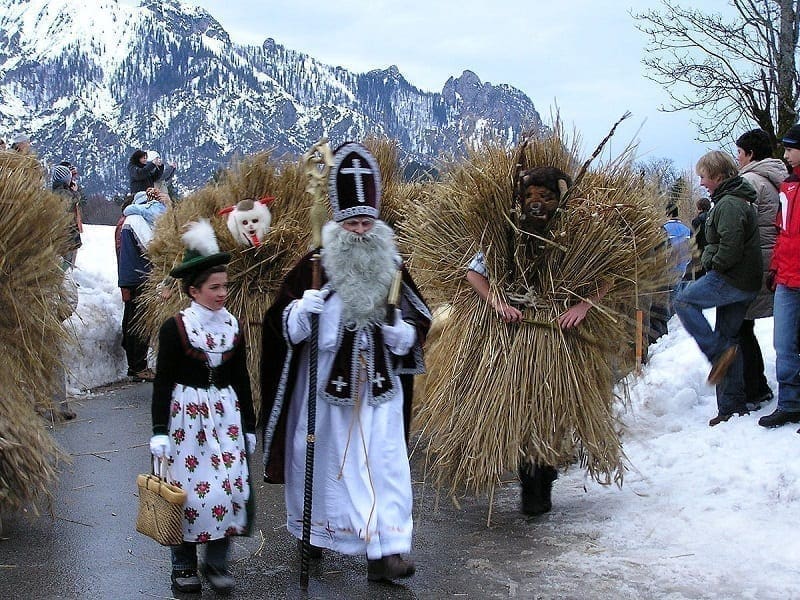My American friends will sometimes ask me What is St Nicholas Day? St. Nicholas (also spelled Nikolas and Nikolaus) is the Patron Saint of Children, and his Feast Day is celebrated on December 6th. The German St Nicholas Tradition is still very strong. Children put out their shoes, hoping they will be filled with goodies and presents.
Ach, du lieber Nikolaus,
komm ganz schnell in unser Haus.
Hab so viel an dich gedacht,
hast mir doch was mitgebracht?Oh my dear Nikolaus,
come very fast to into our house.
I’ve thought about you oh so much,
Did you bring something for me?

What is St Nicholas Day?
How to Celebrate St Nicholas Day
When I was a child we would put a pair of (CLEAN) shoes in front of the door on the evening of Dec 5. (Yes, clean… as a German kid, I learned to polish shoes at an early age). I would find treats and small presents in my shoes when I woke up on the 6th. Sometimes there would be Chocolate in our Stockings (they were hung early, in anticipation of a visit by St. Nicholas).
Sadly, there is no fooling St Nicholas. Putting my father’s boots by the door didn’t help at all… even if they were clean.
![]()
The life story of Saint Nicholas
Nikolas was born into a wealthy family, but he chose to be a monk, and later a priest. When his parents died, he chose to give his inheritance away to the needy. He was known for his kindness, especially to children. Eventually, he became the Bishop of Myra, which is now a part of Turkey. He was arrested during the rule of the Roman Emperor Diocletian for his crime of being a Christian. (Ironically, at the time, the jails were so full of Priests and Bishops; there was no room for robbers and murderers.) After his release he attended the Council of Nicaea. When he died on Dec. 6 325, AD, he was buried in the Cathedral in Myra. It is said that Manna (remember the story of Moses in the desert?) appeared on his grave… and this miracle qualified him for Sainthood.
St Nicholas Making his Rounds- creative commons photo by-Gamsjaga
German St Nicholas Tradition
In Germany, St Nikolaus and his companion, visit homes on the evening of the 5th, and ask whether Children were behaving. St Nikolaus would be dressed in white robes and carrying a book (to double check the year’s transgressions) and his Bishop’s Staff. Kids would be tested for their behavior and asked to recite poems or sing a song. The child would get a gift for doing well. Knecht Ruprecht (in my part of Germany… ) is a more sinister figure, who carried a sack and a switch. Children who were bad could be given a switch or taken away in the sack. YIKES!
To prepare for the visit, children would tidy their rooms and clean their toys. Shoes would be polished and set out by the door or on a windowsill. Some kids even left a bit of hay or straw for St Nicholas’s Donkey) Children still wake to find, candies, gold coins, and even small treats on December 6th.
In some communities, children dress as St Nicholas, and go door to door collecting treats.
St Nicholas and the Christkind
Before Martin Luther and the Protestant Reformation shook up the Catholic church and German beliefs in the 16th Century, St Nicholas day was THE DAY for gift giving. Martin Luther wanted to change the focus away from the Saints, and instead put it on Christ. The story of Christkind as a gift giver… an embodiment of Jesus in the form of an Angel… took over. Instead of Dec. 6, children would receive their gifts on Christmas Eve.
Still, as with every story, things got blurry. Early on the Christkind was thought to travel WITH St Nicholas bringing gifts, almost as if they are companions. And today, many families celebrate both, with small gifts on St Nicholas day… and then gifts from the Christkind on Heilig Abend (Christmas Eve).
Read more about the Christkind here–> Christkind Tradition
The Transformation to the American Santa Claus
Over time, St Nicholas became secularized (transformed from the religious figure to something non-religious by society). His Bishop’s staff became a pipe… and the Bishop’s Miter became just a red hat. St Nicholas Day traditions gave birth to the characters of Santa Claus and Father Christmas. The Clement Clark Moore poem “A Visit from St Nicholas” set up the idea of St Nicholas being a jelly bellied, red suit wearing, jolly man who his arrives in a sleigh loaded with toys for children on Christmas. Later in 1881 German immigrant Thomas Nast, the political cartoonist, reinforced the image by drawing Santa Claus who he based on Belsnickel, who he remembered from growing up in the Palatine region of Germany. He changed Belsnickel’s fur suit to Red and White, to make him friendlier. Santa Claus (the derivation of the Sankt niKLAUS) as a jolly looking fat man. Gone was Knecht Ruprecht and his stick, and the bag was now filled with toys!
In Germany, this Santa Claus figure is known as the Weihnachtsmann... and he comes on Christmas Eve.
St. Nicholas Companions
In the Netherlands (where he is called Sinterklaas), and areas of Germany near the Dutch border, St Nickolas is accompanied by Zwarte Pieten… or Schwartze Peter (Black Peter), a Moor who would put the bad children in a sack and take them back to Spain (remember, the Moors lived in Spain)
Knecht Ruprecht is the most common of his companions. While written stories linking him to St Nicholas first appeared in the 17th century, tales of Knecht Ruprecht go back to the Middle Ages. (Oddly, Ruprecht is another word for Devil.) Stories about him vary. Some think he was a wild foundling raised by St Nicholas to be a manservant. Other stories, described in “Deutsche Mythologie” (German Folklore), Jakob Grimm claim his origin is that of a House Sprite or House Elf, who keeps balance. Either way, he wears a black or brown robe with a hood, and often has small bells at his waist to announce his arrival. His face is dirty from the soot he collects as he goes down chimneys (wondering if this was “borrowed” by the American Santa Claus”?) Some say he carries a bag of coal and walks with a long staff because of a limp from a childhood injury.
In Bavaria and Austria, St Nicholas travels with Krampus. Krampus is a scary, demonic BEAST who drags bad children back to his lair. Sometimes Krampus travels alone. He is in charge of giving out bundles of sticks (Ruten) for beatings, or coal.
Click here to learn more about Krampus
Click to Learn More about St Nicholas’s Companions HERE
Put out Your Shoes!
On the evening of December 5th, remember to put out your shoes. And maybe a little bit of hay or a carrot for St Nikolas’s horse. And if you’ve been good, on December 6th, you might just find special treats from St Nikolas.
Books to fill the shoes…
The Legend of St. Nicholas: A Story of Christmas Giving Saint Nicholas: The Real Story of the Christmas Legend
Saint Nicholas: The Real Story of the Christmas Legend The Baker’s Dozen: A Saint Nicholas Tale, with Bonus Cookie Recipe and Pattern for St. Nicholas Christmas Cookies (15th Anniversary Edition)
The Baker’s Dozen: A Saint Nicholas Tale, with Bonus Cookie Recipe and Pattern for St. Nicholas Christmas Cookies (15th Anniversary Edition)
This is cute… a video of a child being visited by St Nicholas, Krampus and the Angel








The mitre is his hat, not the staff
fixing…
Thank you for the post, very interesting and sense I’m not a Catholic anymore, but I still enjoy reading about the church. I think once you are a Catholic, you still have the church in your heart, I know I do.
Loved this story it brought many memories of my children growing up celebrating St. Nicholas’s Day . It also was my son,Karl’s Birthday so we enjoy treats & cake as well
Happy Birthday!
We would put our slippers on the windowsill when I was a child instead of shoes and out the door. Not sure why since my family was from Germany and we had a German home.
I think that families nudge customs a bit for their own reasons. Maybe somewhere along the line there was a doggie in the family who might have stolen treats from the shoes, so they were moved to a window.
On the other hand, there are plenty of traditions of leaving things on windowsills for gifts, they do it in Italy and Iceland, and many do it in Germany.
I found this blog post really interesting! I had no idea that St Nicholas Day was such a big deal in Germany. It’s great to learn about the different traditions and customs associated with this holiday. I’ll definitely be incorporating some of these practices into my own celebrations this year. Thanks for sharing!